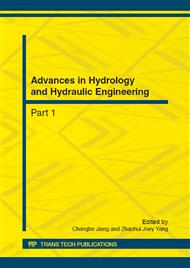[1]
Yin Guangzhi, Wei Zuoan, Xu jiang. Fine tailings and its dam stability analysis. ChongqingUniversity Publishing House(2004).
Google Scholar
[2]
Yuan Bing. Study on the model for tailing dam breaking and its application. China Safety Science Journal, Vol. 4(2008), P. 169.
Google Scholar
[3]
Duan Zhongyuan, Yuan Bing. Collapse analysis and comprehensive treatment of a mine tailings dam due to rain storm and flood impounding. Mechanics and Practice, Vol. 4(2008), P. 40.
Google Scholar
[4]
Li Hongru, Hu Zaiqiang, Chen Cunli. Numerical simulation and slope stability analysis in Jingduicheng tailings dam to be designed to increase the dam height. Rock and Soil Mechanics, Vol. 29(2008), P. 1138.
Google Scholar
[5]
Pan Jianping. Analysis of the seismic stability and geotextile reinforcement effect of tailing dam. Metal Mine, Vol. 393(2009) , P. 19.
Google Scholar
[6]
Wei Zuoan, Yin Guangzhi, Li Guangzhi. Reinforced terraced fields method for fine tailings disposal. Mineral Engineering, Vol. 22(2008), P. 1053.
DOI: 10.1016/j.mineng.2009.03.014
Google Scholar
[7]
Yin G., Wei Z., Wang J.G., Wan L., Shen L. Interaction characteristics of geosynthetics with fine tailings in pullout test. Geosynthetics International, Vol. 15 (2008), P. 428.
DOI: 10.1680/gein.2008.15.6.428
Google Scholar
[8]
Zandarin, Mariat, Oldecop, Luciano A., Rodriguez, Roberto, Zabala, Francisco. The role of capillary water in the stability of tailing dams. Engineering Geology Vol. 105 (2009), P. 108.
DOI: 10.1016/j.enggeo.2008.12.003
Google Scholar
[9]
Guangzhi Yin, Xiaofei Jing, Zuoan Wei. Research on the mine debris flow surging from tailings dam-break based on simulation experiment. Disaster Advance, Vol. 3(2010) , P. 372.
Google Scholar
[10]
Yin guangzhi, Zhang qiangui, Wei zuoan. Study of particle distribution characteristics and mechanical properties for tailings based on fractal theory. Disaster Advance, Vol. 3(2010), P. 586.
Google Scholar
[11]
Qinwen Tan, Guangzhi Yin, Dongwei Li. Application of GIS and Fuzzy Optimization Selection Theory in Tailings Dam Locating[J], Disaster Advance, Vol. 3(2010) , P. 367.
Google Scholar
[12]
Voisin D., Grillaud G., Solliec G., Sayettat Beley A., Berlaud J.L., Miton A. Wind tunnel test method to study out of service tower crane behaviour in storm winds. Journal of Wind Engineering and Industrial Aerodynamics, Vol. 92(2004) , P. 687.
DOI: 10.1016/j.jweia.2004.03.005
Google Scholar
[13]
Borzsonyi, Tamas, Ecke Robert E., McElwaine Jim N. Patterns in flowing sand: understanding the physics of granular flow. Physical Review Letters 178302(2009), P. 1.
DOI: 10.1103/physrevlett.103.178302
Google Scholar
[14]
Li Shaojun, Knappett J A, Feng Xiating. Centrifugal test on slope instability influenced by rise and fall of reservoir water lever. Chinese Journal of Rock Mechanics and Engineering, Vol. 27(2008), P. 1586.
Google Scholar
[15]
Schwartz M O, Schippers A, HAHN L. Hydrochemical models of the sulphidic tailings dumps at matchless (namibia) and selebi-phikwe (botswana). Environmental Geology, Vol. 49 (2006),P. 504.
DOI: 10.1007/s00254-005-0033-z
Google Scholar


